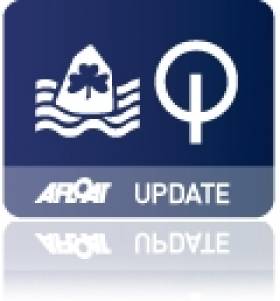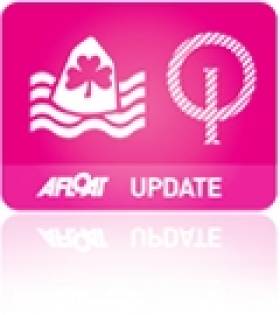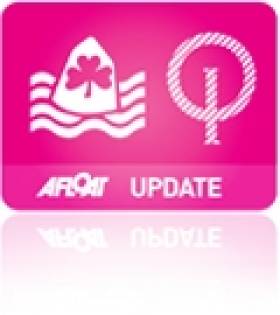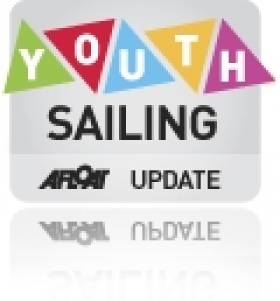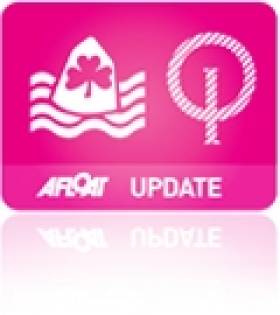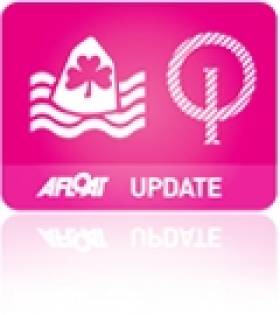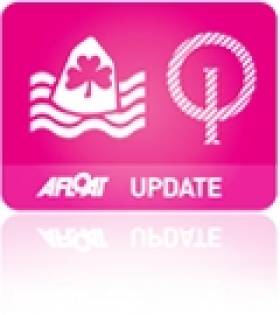Displaying items by tag: Optimist
#oppienationals– British Optimist champion Milo Gill Taylor produced another string of consistent scores in blustery conditions to win the ten race Irish Optimist Open Series in Dun Laoghaire at the weekend. The Spinnaker Sailing Club visitor from Hampshire was 12–points clear in the 59–boat senior fleet. The top Irish result came from Royal Cork's Harry Durcan in fourth place overall, who wins the Irish National title. Second and third overall were taken by Max Clapp and Robbie King of the UK.
South westerly winds produced gusty offshore conditions with some gusts hitting 30–knots over the weekend for the event run by the National Yacht Club and sponsored by the Jelly Bean Factory.
Junior honours in the open series in a massive 89–boat fleet was taken by Germany's Roko Mohr but by the narrowest of margins. Irish European team–member Clare Gorman of the host club in tenth overall won the Irish junior championship title.
The 43–boat in harbour regatta fleet was won by the Royal Irish Yacht Club's Sean O'Shea. Results here
#optimist – Loghlen Rickard of the host club leads local hopes in second overall at the Jelly Bean Factory sponsored Irish Optimist Championships in Dun Laoghaire but English and German sailors are top of the senior and junior fleets after five races. 190 boats are racing from the National Yacht Club since Thursday, a regatta that has drawn considerable interest as next year's Optmist European Championships will be staged on Dublin Bay. Roko Mohr from Germany leads the juniors while Spinnaker Sailing Club's Milo Gill–Taylor, recently crowned British champion, tops the senior fleet. Results are here. Racing continues until Sunday with strong winds forecast tomorrow.
Early Lead Taken By Visitors at Jelly Bean Irish Optimist Nationals
#Optimist – Warsash Optimist sailor Robbie King leads the senior fleet of the 190–boat Irish Optimist national championships at the National Yacht Club this morning. The championship sponsred by the Jelly Bean Factory began yesterday with senior, junior and regatta fleets racing inside and outside Dun Laoghaire harbour in light to medium winds and rain showers.
Second in the senior fleet is Daniel Hopkins of Howth Yacht Club with the host club's Loghlen Rickard third.
The junior fleet is lead by another visitor, Vita Heathcote from Royal Lymington Yacht Club.
The in–harbour regatta fleet is lead by the NYC's Conor Gorman.
Racing, under race officer Con Murphy, continues until Sunday with high winds forecast for Saturday. Full results here
As a novel part of the sponsorship arrangements in Dun Laoghaire, the Jelly Bean Factory has engaged the services of professional marine photographer Aidan Tarbett to photograph the entire fleet and offer photo downloads for free here.
#optimist – Royal Cork's Harry Durcan in 70th place overall was the best of a five boat Irish team at the 51st Optimist World Championship on Lake Garda in Italy last week and this week Durcan is best of Irish Optimist hopes again at the UK Nationals in Largs, Scotland.
Both Durcan brothers are top ten in the senior fleet, but light winds are frustrating progress on the Gourock.
Harry Bell also maintains his position in the top ten in the Junior fleet.
In Italy, Megan Parker was 96th, Durcan's twin brother Johnny was 99th, Alix Buckey 156th, and James McCann 191st. A huge 259–boat fleet competed. Next up for the Optimist class after the UK Nationals is the Irish counterpart in August on Dublin Bay where a number of top international entries are expected. Preparations are already underway at the National Yacht Club venue where its dinghy parking area is to be cleared of members boats for over a month (in the middle of the sailing season) to make way for both the Oppie event and the Laser Europeans that follows.
#OPTI – The 51st Optimist World Championship, organised by Fraglia Vela Riva, Lake Garda Trentino-Italy finished yesterday and a five boat Irish team posted the following results: Harry Durcan 70th, Megan Parker 96th, Johnny Durcan 99th, Alix Buckey 156th, and James McCann 191st.
A massive 259– boat fleet competed. Full results are available to download below.
Eight races were completed for all fleets with the yellow fleet having completed an additional ninth. On the final day's the wind came in at 14-16 knots but gradually decreased towards the end of the first race due to a storm in the mountains behind Riva del Garda. This blocked the revered southerly Ora and brought the echoing sound of thunder to Riva. The fleets were quickly brought ashore.
#youthsailing – In Crozon, south west Brittany, two races were completed in very light wind at the Optimist Summer Cup, attended by 15 Irish sailors including the Irish International Development team.
In Pleneuf Val-Andre on the north Breton coast, day one of the 420 national championships saw racing cancelled due to heavy fog. 10 Irish sailors are in Pleneuf for the event.
Irish Optimist Team Seeking World Honours on Lake Garda
#Optimist – On Wednesday, five Irish Optimist sailors will join almost 250 other sailors from 54 countries for the Optimist World Championships on Lake Garda, Italy.
Racing will continue until Thursday July 25th with a rest day in between.
The Irish squad for the Optimist World Championships 2013: Alex Buckley, Harry Durcan, Johnny Durcan, James McCann and Megan Parker
#opti – The Irish European Optimist team return home later today (Monday) from the 2013 European Championships on Lake Balaton, Hungary, an event that had its fair share of light winds.
The team - RCYC's Richard McGinley and Rebecca O'Shaughnessy, NYC's Loghlen Rickard and Clare Gorman, SSC's Peter Fagan, MYC's Gemma McDowell and HYC's Alex O'Grady, pictured above, will bring with them the flag of IODA, the International Optimist Dinghy Association, in preparation for the 2014 European Championships which will be hosted by the Royal St George Yacht Club.
Conditions at the event were tough for Irish sailors used to wind, as day after day the becalmed fleet returned to shore waiting for the elusive breeze. Nonetheless, the group put up a good fight and in the boys, Richard McGinley was top finisher in 59th and for the girls, Clare Gorman in 43rd position.'
This year's event was won by Ryan Yee Kang Teo of Singapore (Boys) and Mara Turin of Slovenia (girls).
#Opti – Organisers at the European Optimist championships in Lake Balaton, Hungary where an Irish team is competing are struggling to complete races in just five knots of breeze.
Only about half of the scheduled races have been sailed up to lunch time Thursday. The forecast looks a little better for today and Saturday (the last day).
After 4 races top Irish girl is Clare Gorman lying 38th overall from 102 and in the boys Peter Fagan lying 57th from 146 boys.
Top highlights have been Loghlen Rickard's fifth in race two and Clare's sixth in race four.
The conditions appear to be suiting foreign sailors with more experience sailing in tricky light wind lake conditions.
Optimist Juniors Heading for Galway Bay Sailing Club
#opti – This weekend Galway Bay Sailing Club are hosting the Connaught Optimist Championships 2013 in Renville Oranmore, County Galway.
GBSC has been preparing for the event for some weeks now and the club is expecting to have approximately 120 children competing on the water. Below is a preview written by one of GBSC's junior sailors Amy Denny.
This weekend, Saturday and Sunday the 29th and 30th, Galway bay sailing club will host a two day sailing event for children in an optimist dinghy. The optimist is a small boat which is solo sailed. Previous Optimist sailors like Annalise Murphy have represented Ireland in the Olympics. 150 Children ranging in ages from 8 to 15 years will travel from all over the country to compete in a series of sailing races. Each race lasts about an hour, and there will be a minimum of 5 races.
Volunteers have been getting their hands dirty, painting, weeding and tidying the sailing club which is located in Renville, Oranmore.
The club will hopefully have a great day. Pop along and see what is happening at the club this summer with summer camps for all ages – Amy Denny (Optimist Sailor, Aged 12)


























